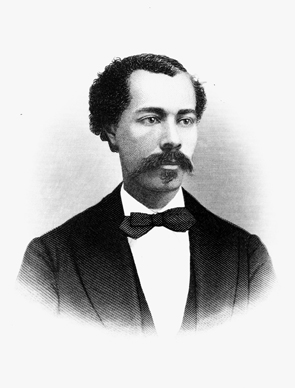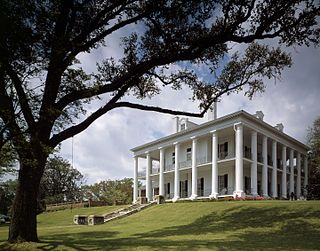
Washington County is a county located in the U.S. state of Mississippi. As of the 2020 census, the population was 44,922. Its county seat is Greenville. The county is named in honor of the first president of the United States, George Washington. It is located to the Arkansas border.

Ouachita Parish is located in the northern part of the U.S. state of Louisiana. As of the 2020 census, the population was 160,368. The parish seat is Monroe. The parish was formed in 1807.

Natchez is the only city in and the county seat of Adams County, Mississippi, United States. It has a total population of 14,520. Located on the Mississippi River across from Vidalia in Concordia Parish, Louisiana, Natchez was a prominent city in the antebellum years, a center of cotton planters and Mississippi River trade.

John Anthony Quitman was an American lawyer, politician, and soldier. As President of the Mississippi Senate, he served one month as Acting Governor of Mississippi as a Whig. He was elected Governor in 1850 as a Democrat, and served from January 10, 1850, until his resignation on February 3, 1851, shortly after his arrest for violating U.S. neutrality laws. He was strongly pro-slavery and a leading Fire-Eater.

Robert John Walker was an American lawyer, economist and politician. An active member of the Democratic Party, he served as a member of the U.S. Senate from Mississippi from 1835 until 1845, as Secretary of the Treasury from 1845 to 1849 during the administration of President James K. Polk, and briefly as Territorial Governor of Kansas in 1857. He was responsible for drafting the 1849 bill that eventually established the United States Department of the Interior.

Luke Pryor was a U.S. senator from the state of Alabama. He was appointed to fill the Senate term left by the death of George S. Houston and served from January 7 to November 23, 1880, when a replacement was elected. Pryor was a Democrat. He is interred at City Cemetery in Athens, Alabama.
The Natchez District was one of two areas established in the Kingdom of Great Britain's West Florida colony during the 1770s – the other being the Tombigbee District. The first Anglo settlers in the district came primarily from other parts of British America. The district was recognized to be the area east of the Mississippi River from Bayou Sara in the south and Bayou Pierre in the north.

John Roy Lynch was an American writer, attorney, military officer, author, and Republican politician who served as Speaker of the Mississippi House of Representatives and represented Mississippi in the United States House of Representatives.
Benjamin Thornton Montgomery (1819–1877) was an American inventor, landowner, and freedman in Mississippi. He was taught to read and write English, and became manager of supply and shipping for Joseph Emory Davis at Hurricane Plantation at Davis Bend.
John Benjamin Pryor, was an American Thoroughbred racehorse trainer. He trained Lexington, a top racehorse of the 1850s whose excellence in competition and reputation as a sire stud continued well into the 20th century, earning the horse induction into the United States' National Museum of Racing and Hall of Fame in 1955.
Francis Everod Rives was a Virginia Democratic politician and businessman who served two terms in the United States House of Representatives. After making his fortune as a slave trader, Rives became a planter and soon won election and re-election multiple times to both houses of the Virginia General Assembly before his two terms representing Virginia's 2nd congressional district, and afterward represented several counties near Petersburg in the Virginia Senate as well as served as the city's mayor. Rives also helped establish the state-chartered Petersburg Railroad.

Dunleith is an antebellum mansion at 84 Homochitto Street in Natchez, Mississippi. Built about 1855, it is Mississippi's only surviving example of a plantation house with a fully encircling colonnade of Greek Revival columns, a form once seen much more frequently than today. Now an inn and conference center, it was designated a National Historic Landmark in 1974. Currently the original horse stable serves as a fine dining establishment with a traditional English pub in the lower levels of the structure

William Lindsay Brandon was a medical doctor, state legislator, planter and military officer best known for having served as a general in the Confederate States Army during the American Civil War. Brandon was born c. 1801–1802, though his exact birthdate is indeterminate.

Stephen Duncan was an American planter and banker in Mississippi during the Antebellum South. He was born and studied medicine in Pennsylvania, but moved to Natchez District, Mississippi Territory in 1808 and became the wealthiest cotton planter and the second-largest slave owner in the United States with over 2,200 slaves. He owned 15 cotton and sugar plantations, served as President of the Bank of Mississippi, and held major investments in railroads and lumber.

David Hunt was an American planter based in the Natchez District of Mississippi who controlled 25 plantations, thousands of acres, and more than 1,000 slaves in the antebellum era. From New Jersey, he joined his uncle in Mississippi business. He became a major philanthropist in the South, contributing to educational institutions in Mississippi, as well as the American Colonization Society and Mississippi Colonization Society, the latter of which he was a founding member.

Captain William J. Minor was an American planter, slave owner, and banker in the antebellum South. Educated in Philadelphia, he lived at the Concord plantation in Natchez, Mississippi, and served as the second President of the Agricultural Bank. He was the owner of three large sugar plantations in Louisiana and supported the Union during the Civil War for the stability of the sugar trade.
Levin R. Marshall was an American banker and planter in the Antebellum South. He was a founder and President of the Commercial Bank of Natchez, Mississippi. He owned 14,000 acres in Mississippi and Louisiana, and 10,000 acres in Arkansas.

The Cypress Grove Plantation was a Southern plantation owned by President Zachary Taylor near Rodney, Mississippi. Later, it was also known as Buena Vista Plantation.

Homewood Plantation was a historic plantation with a mansion of the same name located on it in Natchez, Adams County, Mississippi. Built in 1860 as a wedding present for the Southern belle Catherine Hunt, the daughter of millionaire planter David Hunt, the mansion remained unscathed during the American Civil War of 1861-1865. By the early twentieth century, it was used as a shooting location for 1915 classic film The Birth of a Nation. The author Stark Young used Homewood as the setting of a wedding in his 1934 novel So Red the Rose. The mansion burnt down in 1940.

The city of Natchez, Mississippi, was founded in 1716 as Fort Rosalie, and renamed for the Natchez people in 1763.
















